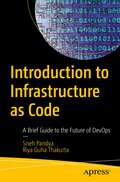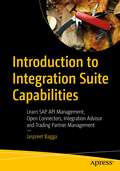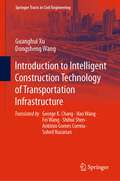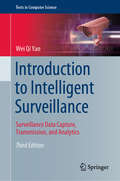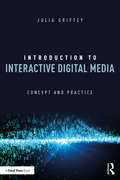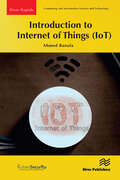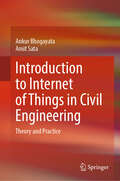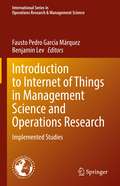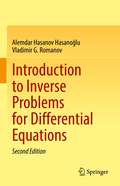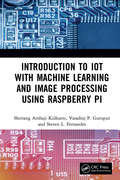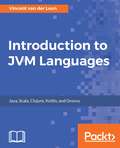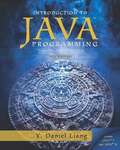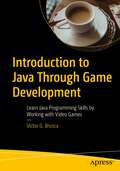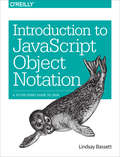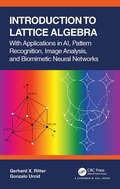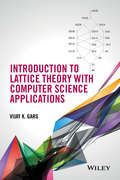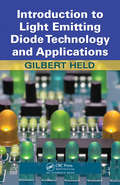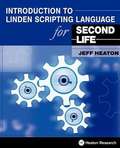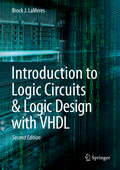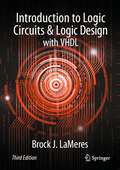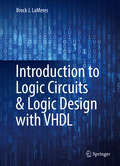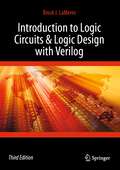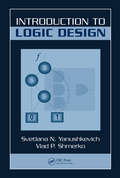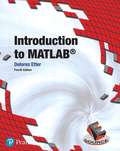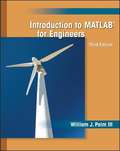- Table View
- List View
Introduction to Infrastructure as Code: A Brief Guide to the Future of DevOps
by Sneh Pandya Riya Guha ThakurtaGet inspired to explore the depths of the DevOps field. In today’s rapidly transforming world, Infrastructure as Code (IaC) has emerged as an effective approach to maintain, scale, and deploy software systems. This book offers a mixture of foundational IaC concepts and practical examples to give you hands-on experience.You will first gain an understanding of DevOps culture as well as how to adapt to IaC. Introduction to Infrastructure as Code begins by reviewing the innovative features that DevOps in general, and IaC in particular, have to offer for adoption and growth for different verticals. With this solid base established, you will then learn the importance, processes, and outcome of building infrastructure solutions.Authors Sneh Pandya and Riya Guha Thakurta then provide hands-on examples utilizing IaC platforms, open source tools, and essential considerations such as security, scalability, and deployments. Each chapter focuses on one vertical (i.e., foundations, architecture patterns, securing infrastructure, preparing for deployment), how it impacts the DevOps toolchain in a holistic manner, and how it can be used to build solutions specific to that vertical, with a detailed walkthrough of code, environments, and other tools. After completing this book, you’ll have launched your own infrastructure solution through an open source stack consisting of platforms and tools such as Terraform, Chef, and Puppet.What You Will LearnUnderstand the fundamentals of DevOps and Infrastructure as CodePrepare for the ever-evolving ecosystem of modular infrastructure and the needs of the futureAvoid potential pitfalls and breakdowns while working with infrastructureBuild scalable and efficient IaC solutions that work at a small, medium, and large scale in a real-life environmentUnderstand and be responsibly aware of security concerns related to the domain, and how to address themWho Is This Book ForBeginners interested in building a career in DevOps as well as professionals looking to gain expertise and advance their career with greater knowledge of IaC. including Technical Product Managers, and Architects.
Introduction to Integration Suite Capabilities: Learn SAP API Management, Open Connectors, Integration Advisor and Trading Partner Management
by Jaspreet BaggaDiscover the power of SAP Integration Suite's capabilities with this hands-on guide. Learn how this integration platform (iPaaS) can help you connect and automate your business processes with integrations, connectors, APIs, and best practices for a faster ROI. Over the course of this book, you will explore the powerful capabilities of SAP Integration Suite, including API Management, Open Connectors, Integration Advisor, Trading Partner Management, Migration Assessment, and Integration Assessment. With detailed explanations and real-world examples, this book is the perfect resource for anyone looking to unlock the full potential of SAP Integration Suite. With each chapter, you'll gain a greater understanding of why SAP Integration Suite can be the proverbial swiss army knife in your toolkit to design and develop enterprise integration scenarios, offering simplified integration, security, and governance for your applications. Author Jaspreet Bagga demonstrates how to create, publish, and monitor APIs with SAP API Management, and how to use its features to enhance your API lifecycle. He also provides a detailed walkthrough of how other capabilities of SAP Integration Suite can streamline your connectivity, design, development, and architecture methodology with a tool-based approach completely managed by SAP. Whether you are a developer, an architect, or a business user, this book will help you unlock the potential of SAP's Integration Suite platform, API Management, and accelerate your digital transformation. What You Will Learn Understand what APIs are, what they are used for, and why they are crucial for building effective and reliable applicationsGain an understanding of SAP Integration Suite's features and benefits Study SAP Integration assessment process, patterns, and much moreExplore tools and capabilities other than the Cloud Integration that address the full value chain of the enterprise integration components Who This Book Is For Web developers and application leads who want to learn SAP API Management.
Introduction to Intelligent Construction Technology of Transportation Infrastructure (Springer Tracts in Civil Engineering)
by Dongsheng Wang Guanghui XuThis book expounds on the related technologies of intelligent transportation infrastructure construction. Based on the essential characteristics of intelligent construction, "perception, analysis, decision-making, and execution," the basic structure of intelligent construction technology (ICT) is established. With the integration of engineering construction technologies, the analyses of the essence of intelligent algorithms and the feasibility of Artificial Intelligence (AI) are provided. The book introduces the essential characteristics of Big Data and the Internet of Things and their relationship with engineering construction. On this basis, the feasibility and implementation plan of intelligent technology applications in design, construction, and maintenance are analyzed and demonstrated with engineering examples. The book also combines ICT with intelligent construction talent training, the professional knowledge required for intelligent construction, and the theoretical basis to provide the methods for mastering new technologies. This book can be used by technical personnel in related fields such as highways, railways, airports, and urban road construction to understand and master innovative, intelligent construction technologies. It can also be a reference book for ICT-related college courses.
Introduction to Intelligent Surveillance: Surveillance Data Capture, Transmission, and Analytics (Texts in Computer Science)
by Wei Qi YanThis practically-oriented textbook introduces the fundamentals of designing digital surveillance systems powered by intelligent computing techniques. The text offers comprehensive coverage of each aspect of the system, from camera calibration and data capture, to the secure transmission of surveillance data, in addition to the detection and recognition of individual biometric features and objects. The coverage concludes with the development of a complete system for the automated observation of the full lifecycle of a surveillance event, enhanced by the use of artificial intelligence and supercomputing technology.This updated third edition presents an expanded focus on human behavior analysis and privacy preservation, as well as deep learning methods.Topics and features: contains review questions and exercises in every chapter, together with a glossary; describes the essentials of implementing an intelligent surveillance system and analyzing surveillance data, including a range of biometric characteristics; examines the importance of network security and digital forensics in the communication of surveillance data, as well as issues of issues of privacy and ethics; discusses the Viola-Jones object detection method, and the HOG algorithm for pedestrian and human behavior recognition; reviews the use of artificial intelligence for automated monitoring of surveillance events, and decision-making approaches to determine the need for human intervention; presents a case study on a system that triggers an alarm when a vehicle fails to stop at a red light, and identifies the vehicle’s license plate number; investigates the use of cutting-edge supercomputing technologies for digital surveillance, such as FPGA, GPU and parallel computing.This concise and accessible work serves as a classroom-tested textbook for graduate-level courses on intelligent surveillance. Researchers and engineers interested in entering this area will also find the book suitable as a helpful self-study reference.
Introduction to Interactive Digital Media: Concept and Practice
by Julia V. GriffeyThis book offers a clearly written and engaging introduction to the basics of interactive digital media. As our reliance on and daily usage of websites, mobile apps, kiosks, games, VR/AR and devices that respond to our commands has increased, the need for practitioners who understand these technologies is growing. Author Julia Griffey provides a valuable guide to the fundamentals of this field, offering best practices and common pitfalls throughout. The book also notes opportunities within the field of interactive digital media for professionals with different types of skills, and interviews with experienced practitioners offer practical wisdom for readers. Additional features of this book include: An overview of the history, evolution and impact of interactive media; A spotlight on the development process and contributing team members; Analysis of the components of interactive digital media and their design function (graphics, animation, audio, video, typography, color); An introduction to coding languages for interactive media; and A guide to usability in interactive media. Introduction to Interactive Digital Media will help both students and professionals understand the varied creative, technical, and collaborative skills needed in this exciting and emerging field.
Introduction to Internet of Things (River Publishers Series in Rapids in Computing and Information Science and Technology)
by Ahmed BanafaThis book introduces the Internet of Things (IoT), which is the convergence of connecting people, things, data and processes; it is transforming our life, business and everything in between. By 2025, experts forecast that up to 75 billion devices will be connected to the Internet with only one third of them being computers, smartphones, smartwatches, and tablets. The remaining two thirds will be other "devices" – sensors, terminals, household appliances, thermostats, televisions, automobiles, production machinery, urban infrastructure and many other "things", which traditionally have not been Internet enabled. This "Internet of Things" (IoT) represents a remarkable transformation of the way in which our world will soon interact. Much like the World Wide Web connected computers to networks, and the next evolution mobile devices connected people to the Internet and other people, IoT looks poised to interconnect devices, people, environments, virtual objects and machines in ways that only science fiction writers could have imagined.
Introduction to Internet of Things in Civil Engineering: Theory and Practice
by Ankur Bhogayata Amit SataThis textbook provides introductory concepts of the Internet of Things (IoT) in a concise and clear format. It presents in-depth information on the technological transformations and attributes of IoT. It also presents various examples of the applications of IoT in the field of civil engineering, both in laboratories and in the field. Various self-explanatory illustrations, figures, photographs and numerical details are included for a better understanding of concepts. A summary of contents and a list of review questions are provided at the end of each section for self-evaluation of the learnings from each chapter. A dedicated chapter for teachers is also provided which discusses pedagogy and curriculum development for the emerging field of IoT with reference to civil engineering education. The book also suggests methods of utilisation and integration of IoT concepts in education through assignments, tutorials, project works and research topics. This book is a valuable learning resource for undergraduate civil engineering students with limited exposure to computer science and engineering. It also functions as a reference resource for postgraduate students and scholars dealing with the application of IoT in civil engineering.
Introduction to Internet of Things in Management Science and Operations Research: Implemented Studies (International Series in Operations Research & Management Science #311)
by Fausto Pedro García Márquez Benjamin LevThis book aims to provide relevant theoretical frameworks and the latest empirical research findings in Internet of Things (IoT) in Management Science and Operations Research. It starts with basic concept and present cases, applications, theory, and potential future. The contributed chapters to the book cover wide array of topics as space permits. Examples are from smart industry; city; transportation; home and smart devices. They present future applications, trends, and potential future of this new discipline. Specifically, this book provides an interface between the main disciplines of engineering/technology and the organizational, administrative, and planning capabilities of managing IoT. This book deals with the implementation of latest IoT research findings in practice at the global economy level, at networks and organizations, at teams and work groups and, finally, IoT at the level of players in the networked environments. This book is intended for professionals in the field of engineering, information science, mathematics, economics, and researchers who wish to develop new skills in IoT, or who employ the IoT discipline as part of their work. It will improve their understanding of the strategic role of IoT at various levels of the information and knowledge organization. The book is complemented by a second volume of the same editors with practical cases.
Introduction to Inverse Problems for Differential Equations
by Vladimir G. Romanov Alemdar Hasanov HasanoğluThis book presents a systematic exposition of the main ideas and methods in treating inverse problems for PDEs arising in basic mathematical models, though it makes no claim to being exhaustive. Mathematical models of most physical phenomena are governed by initial and boundary value problems for PDEs, and inverse problems governed by these equations arise naturally in nearly all branches of science and engineering.The book’s content, especially in the Introduction and Part I, is self-contained and is intended to also be accessible for beginning graduate students, whose mathematical background includes only basic courses in advanced calculus, PDEs and functional analysis. Further, the book can be used as the backbone for a lecture course on inverse and ill-posed problems for partial differential equations.In turn, the second part of the book consists of six nearly-independent chapters. The choice of these chapters was motivated by the fact that the inverse coefficient and source problems considered here are based on the basic and commonly used mathematical models governed by PDEs. These chapters describe not only these inverse problems, but also main inversion methods and techniques. Since the most distinctive features of any inverse problems related to PDEs are hidden in the properties of the corresponding solutions to direct problems, special attention is paid to the investigation of these properties.For the second edition, the authors have added two new chapters focusing on real-world applications of inverse problems arising in wave and vibration phenomena. They have also revised the whole text of the first edition.
Introduction to IoT with Machine Learning and Image Processing using Raspberry Pi
by Shrirang Ambaji Kulkarni Varadrah P. Gurupur Steven L. FernandesMachine Learning a branch of Artificial Intelligence is influencing the society, industry and academia at large. The adaptability of Python programming language to Machine Learning has increased its popularity further. Another technology on the horizon is Internet of Things (IoT). The present book tries to address IoT, Python and Machine Learning along with a small introduction to Image Processing. If you are a novice programmer or have just started exploring IoT or Machine Learning with Python, then this book is for you. Features: Raspberry Pi as IoT is described along with the procedure for installation and configuration. A simple introduction to Python Programming Language along with its popular library packages like NumPy, Pandas, SciPy and Matplotlib are dealt in an exhaustive manner along with relevant examples. Machine Learning along with Python Scikit-Learn library is explained to audience with an emphasis on supervised learning and classification. Image processing on IoT is introduced to the audience who love to apply Machine Learning algorithms to Images The book follows hands-on approach and provide a huge collection of Python programs.
Introduction to JVM Languages
by Vincent Van LeunExplore the Java Virtual Machine with modern programming languages About This Book • This guide provides in-depth coverage of the Java Virtual Machine and its features • Filled with practical examples, this book will help you understand the core concepts of Java, Scala, Clojure, Kotlin, and Groovy • Work with various programming paradigms and gain knowledge about imperative, object-oriented and functional programming Who This Book Is For This book is meant for programmers who are interested in the Java Virtual Machine (JVM) and want to learn more about the most popular programming languages that can be used for JVM development. Basic practical knowledge of a modern programming language that supports object-oriented programming (JavaScript, Python, C#, VB.NET, and C++) is assumed. What You Will Learn • Gain practical information about the Java Virtual Machine • Understand the popular JVM languages and the Java Class Library • Get to know about various programming paradigms such as imperative, object-oriented, and functional • Work with common JVM tools such as Eclipse IDE, Gradle, and Maven • Explore frameworks such as SparkJava, Vert.x, Akka and JavaFX • Boost your knowledge about dialects of other well-known programming languages that run on the JVM, including JavaScript, Python, and Ruby In Detail Anyone who knows software development knows about the Java Virtual Machine. The Java Virtual Machine is responsible for interpreting Java byte code and translating it into actions. In the beginning, Java was the only programming language used for the JVM. But increasing complexity of the language and the remarkable performance of the JVM created an opening for a new generation of programming languages. If you want to build a strong foundation with the Java Virtual Machine and get started with popular modern programming languages, then this book is for you. The book will begin with a general introduction of the JVM and its features, which are common to the JVM languages, helping you get abreast with its concepts. It will then dive into explaining languages such as Java, Scala, Clojure, Kotlin, and Groovy and will show how to work with each language, their features, use cases, and pros and cons. By writing example projects in those languages and focusing on each language's strong points, it will help you find the programming language that is most appropriate for your particular needs. By the end of the book, you will have written multiple programs that run on the Java Virtual Machine and know about the differences between the various languages. Style and approach This practical, example-filled guide will help you get started with the JVM and some of its most popular languages.
Introduction to Java Programming, Comprehensive Version
by Y. Daniel LiangThis text is intended for a 1-, 2-, or 3-semester CS1 course sequence. Comprehensive coverage of Java and programming make this a useful reference for beginning programmers and IT professionals. Daniel Liang teaches concepts of problem-solving and object-oriented programming using a fundamentals-first approach. Beginning programmers learn critical problem-solving techniques then move on to grasp the key concepts of object-oriented, GUI programming, advanced GUI and Web programming using Java. Liang approaches Java GUI programming using JavaFX, not only because JavaFX is much simpler for new Java programmers to learn and use but because it has replaced Swing as the new GUI tool for developing cross-platform-rich Internet applications on desktop computers, on hand-held devices, and on the Web.
Introduction to Java Through Game Development: Learn Java Programming Skills by Working with Video Games
by Victor G. BruscaInterested in learning how to program with Java? Let’s face it, the best way to learn to program is by writing programs. This can be a daunting proposition with the specter of hours of simple command line example programs hanging over your head. Fear not! Now you can learn to program in Java in a fun way by working on video games. With this book, you’ll get to work with three Java game projects and have access to the complete game code for each project, including a full Java game engine. After completing Introduction to Java through Game Development, you’ll be proficient in Java programming, having worked with the language’s fundamental aspects throughout the text, and will be ready to further your Java and game programming expertise with confidence.What You'llMaster the fundamentals of the Java programming languageUse different data structures like arrays, lists, stacks, and queuesUnderstand game programming basics including the main game loopGain experience working with three different game projects via the book’s coding challengesWork with the 2D game engine that powers the book's included games and learn to create your own new game projectsUnderstand advanced Java topics like classes, encapsulation, inheritance, and polymorphismWork with exceptions and how to use debugging techniques to trace through codeSharpen your skills with over a dozen coding challenges that test your abilities with a development task on a real game projectWho This Book Is ForThis book requires little to no programming experience to understand and benefit from the text.
Introduction to JavaScript Object Notation: A To-the-Point Guide to JSON
by Lindsay BassettWhat is JavaScript Object Notation (JSON) and how can you put it to work? This concise guide helps busy IT professionals get up and running quickly with this popular data interchange format, and provides a deep understanding of how JSON works. Author Lindsay Bassett begins with an overview of JSON syntax, data types, formatting, and security concerns before exploring the many ways you can apply JSON today.From Web APIs and server-side language libraries to NoSQL databases and client-side frameworks, JSON has emerged as a viable alternative to XML for exchanging data between different platforms. If you have some programming experience and understand HTML and JavaScript, this is your book.Learn why JSON syntax represents data in name-value pairsExplore JSON data types, including object, string, number, and arrayFind out how you can combat common security concernsLearn how the JSON schema verifies that data is formatted correctlyExamine the relationship between browsers, web APIs, and JSONUnderstand how web servers can both request and create dataDiscover how jQuery and other client-side frameworks use JSONLearn why the CouchDB NoSQL database uses JSON to store data
Introduction to Lattice Algebra: With Applications in AI, Pattern Recognition, Image Analysis, and Biomimetic Neural Networks
by Gerhard X. Ritter Gonzalo UrcidLattice theory extends into virtually every branch of mathematics, ranging from measure theory and convex geometry to probability theory and topology. A more recent development has been the rapid escalation of employing lattice theory for various applications outside the domain of pure mathematics. These applications range from electronic communication theory and gate array devices that implement Boolean logic to artificial intelligence and computer science in general. Introduction to Lattice Algebra: With Applications in AI, Pattern Recognition, Image Analysis, and Biomimetic Neural Networks lays emphasis on two subjects, the first being lattice algebra and the second the practical applications of that algebra. This textbook is intended to be used for a special topics course in artificial intelligence with a focus on pattern recognition, multispectral image analysis, and biomimetic artificial neural networks. The book is self-contained and – depending on the student’s major – can be used for a senior undergraduate level or first-year graduate level course. The book is also an ideal self-study guide for researchers and professionals in the above-mentioned disciplines. Features Filled with instructive examples and exercises to help build understanding Suitable for researchers, professionals and students, both in mathematics and computer science Every chapter consists of exercises with solution provided online at www.Routledge.com/9780367720292
Introduction to Lattice Theory with Computer Science Applications
by Vijay K. GargA computational perspective on partial order and lattice theory, focusing on algorithms and their applications This book provides a uniform treatment of the theory and applications of lattice theory. The applications covered include tracking dependency in distributed systems, combinatorics, detecting global predicates in distributed systems, set families, and integer partitions. The book presents algorithmic proofs of theorems whenever possible. These proofs are written in the calculational style advocated by Dijkstra, with arguments explicitly spelled out step by step. The author's intent is for readers to learn not only the proofs, but the heuristics that guide said proofs. Introduction to Lattice Theory with Computer Science Applications: Examines; posets, Dilworth's theorem, merging algorithms, lattices, lattice completion, morphisms, modular and distributive lattices, slicing, interval orders, tractable posets, lattice enumeration algorithms, and dimension theory Provides end of chapter exercises to help readers retain newfound knowledge on each subject Includes supplementary material at www.ece.utexas.edu/~garg Introduction to Lattice Theory with Computer Science Applications is written for students of computer science, as well as practicing mathematicians.
Introduction to Light Emitting Diode Technology and Applications
by Gilbert HeldRecent improvements in LED technology have made them as ubiquitous as cell phones. In fact, LEDs light up almost all cell phones screens. The technology's myriad applications and low energy use have made it nearly impossible to get through daily chores without coming in contact with LEDs. Probable advances include increased ability of the technology to support more efficient lighting and enhanced communications. With balanced coverage of the basics and future developments, Introduction to Light Emitting Diode Technology and Applications takes you on a tour of the LED evolution. The book begins with a brief history of the effort to enable the device that generates light through modern organic LEDs and reviews the fundamentals and principles of light prior to a detailed explanation of how LEDs generate different colors. After forming this basic foundation, the book examines the key LEDs in lighting and communications. It then discusses the latest opportunities and advancements in high brightness (HB) LED technology, solid state lighting, and handheld electronic applications.As we approach a new decade the role of LEDs is literally set to explode, with organic light emitting diodes emerging as a leading next generation technology for electronic displays and lighting. Challenges still exist, including light extraction, luminosity, and white light generation, not to mention non-technical obstacles such as IP disputes and the lack of standards. This book provides a foundation for resolving these issues and developing new applications for LEDs in the promising general illumination market.
Introduction to Linden Scripting Language for Second Life
by Jeff HeatonThe Linden Scripting Language allows residents of the Second Life World to program the three dimensional objects around them. Without this programming objects built in Second Life are motionless and non-interactive. Adding a script enables an object to interact with the world around it. Second Life scripts allow objects such as cars, planes, amusement park rides, weapons and other entertainment devices to be created. This book teaches the beginning Second Life programmer to make use of the basics of the Linden Scripting Language. Language fundamentals, such as variables, loops, lists, events, functions and state machines are covered. The book then moves to more advanced topics such as user interaction and non-physical movement. Later chapters show how to use the Second Life physics engine to create vehicles.
Introduction to Logic Circuits & Logic Design with VHDL
by Brock J. LaMeresThis textbook introduces readers to the fundamental hardware used in modern computers. The only pre-requisite is algebra, so it can be taken by college freshman or sophomore students or even used in Advanced Placement courses in high school. This book presents both the classical approach to digital system design (i.e., pen and paper) in addition to the modern hardware description language (HDL) design approach (computer-based). This textbook enables readers to design digital systems using the modern HDL approach while ensuring they have a solid foundation of knowledge of the underlying hardware and theory of their designs. This book is designed to match the way the material is actually taught in the classroom. Topics are presented in a manner which builds foundational knowledge before moving onto advanced topics. The author has designed the content with learning goals and assessment at its core. Each section addresses a specific learning outcome that the learner should be able to “do” after its completion. The concept checks and exercise problems provide a rich set of assessment tools to measure learner performance on each outcome. This book can be used for either a sequence of two courses consisting of an introduction to logic circuits (Chapters 1-7) followed by logic design (Chapters 8-13) or a single, accelerated course that uses the early chapters as reference material.
Introduction to Logic Circuits & Logic Design with VHDL
by Brock J. LaMeresThis textbook introduces readers to the fundamental hardware used in modern computers. The only pre-requisite is algebra, so it can be taken by college freshman or sophomore students or even used in Advanced Placement courses in high school. This book presents both the classical approach to digital system design (i.e., pen and paper) in addition to the modern hardware description language (HDL) design approach (computer-based). This textbook enables readers to design digital systems using the modern HDL approach while ensuring they have a solid foundation of knowledge of the underlying hardware and theory of their designs. This book is designed to match the way the material is actually taught in the classroom. Topics are presented in a manner which builds foundational knowledge before moving onto advanced topics. The author has designed the content with learning goals and assessment at its core. Each section addresses a specific learning outcome that the learner should be able to “do” after its completion. The concept checks and exercise problems provide a rich set of assessment tools to measure learner performance on each outcome. This book can be used for either a sequence of two courses consisting of an introduction to logic circuits (Chapters 1-7) followed by logic design (Chapters 8-14) or a single, accelerated course that uses the early chapters as reference material.
Introduction to Logic Circuits & Logic Design with VHDL
by Brock J. LameresThis textbook for a one-semester course in Digital Systems Design introduces students to the fundamental hardware used in modern computers. Coverage includes both the classical approach to digital system design (i. e. , pen and paper) in addition to the modern hardware description language (HDL) design approach (computer-based). Using this textbook enables readers to design digital systems using the modern HDL approach, but they have a broad foundation of knowledge of the underlying hardware and theory of their designs. This book is designed to match the way the material is actually taught in the classroom. Topics are presented in a manner which builds foundational knowledge before moving onto advanced topics. The author has designed the presentation with learning Goals and assessment at its core. Each section addresses a specific learning outcome that the student should be able to "do" after its completion. The concept checks and exercise problems provide a rich set of assessment tools to measure student performance on each outcome.
Introduction to Logic Circuits & Logic Design with Verilog
by Brock J. LaMeresThis textbook for courses in Digital Systems Design introduces students to the fundamental hardware used in modern computers. Coverage includes both the classical approach to digital system design (i.e., pen and paper) in addition to the modern hardware description language (HDL) design approach (computer-based). Using this textbook enables readers to design digital systems using the modern HDL approach, but they have a broad foundation of knowledge of the underlying hardware and theory of their designs. This book is designed to match the way the material is actually taught in the classroom. Topics are presented in a manner which builds foundational knowledge before moving onto advanced topics. The author has designed the presentation with learning goals and assessment at its core. Each section addresses a specific learning outcome that the student should be able to “do” after its completion. The concept checks and exercise problems provide a rich set of assessment tools to measure student performance on each outcome.
Introduction to Logic Design
by Svetlana N. Yanushkevich Vlad P. ShmerkoWith an abundance of insightful examples, problems, and computer experiments, Introduction to Logic Design provides a balanced, easy-to-read treatment of the fundamental theory of logic functions and applications to the design of digital devices and systems. Requiring no prior knowledge of electrical circuits or electronics, it supplies the
Introduction to MATLAB
by Delores EtterThis book is appropriate for use as an introductory engineering text or as a supplemental text in an advanced course. It is also useful as a professional reference. The text will introduce engineering problem solving with the following objectives: (i) Present a consistent methodology for solving engineering problems; (ii) Describe the exceptional computational and visualization capabilities of MATLAB; and (iii) Illustrate the problem-solving process through a variety of engineering examples and applications. Throughout the text, emphasis is placed on incorporating real-world engineering and scientific examples with solutions and usable code. Each chapter ends with a Summary that reviews the topics covered and includes a list of Key Terms. A MATLAB Summary lists all the special symbols, commands, and functions defined in the chapter. Hints are provided to help the student avoid some of the common errors.
Introduction to MATLAB for Engineers
by William J. PalmIntroduction to MATLAB for Engineersis a simple, concise book designed to be useful for beginners and to be kept as a reference. The terminology, syntax, and the use of the programming language are well defined, and the organization of the material makes it easy to locate information and navigate through the textbook. The text covers all the major capabilities of MATLAB that are useful for beginning students.
